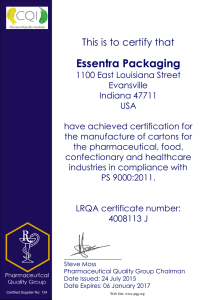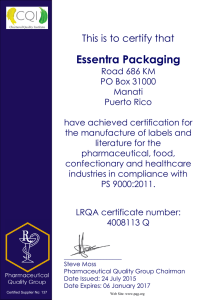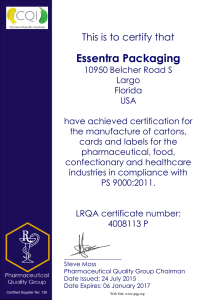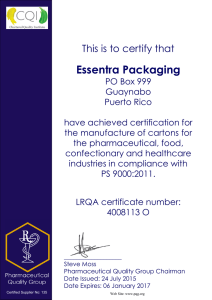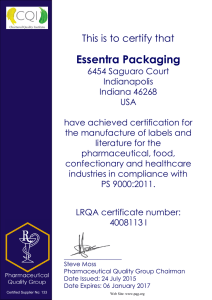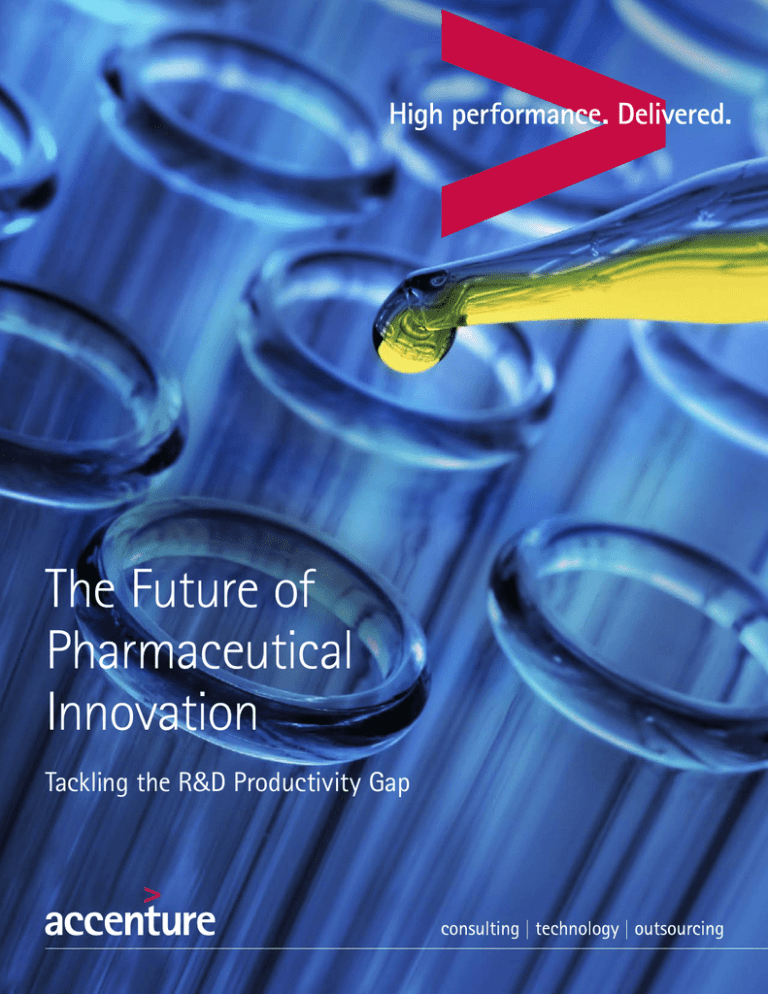
The Future of
Pharmaceutical
Innovation
Tackling the R&D Productivity Gap
Page 2 | The Future of Pharmaceutical Innovation
The Innovation Challenge
Pharmaceutical innovation is facing a
troubled and uncertain future. Critical
performance metrics highlight the
extent of the challenge.1
• Blockbusters - Blockbusters
are increasingly rare, and most
major pharmaceutical companies
are facing substantial patent
expirations.
• New Molecular Entities
(NMEs) - The number of NMEs
has been steadily declining over
the past 15 years with no change
in the downward trend expected.
Performance indicators reveal the most
significant challenge for pharmaceutical
R&D is the productivity decline. The
industry is developing fewer new molecular
entities (NMEs), and the cost for each
is increasing. Blockbuster drugs, once
the industry’s historical success recipe,
are more difficult to identify and face
significant reimbursement challenges.
Leading companies are more reliant on
external molecules from smaller biotechs
as sources of new products. The industry
is exploring targeted therapies and patient
sub-segmentation to support predictive
efficacy, better attrition rates and
potentially attractive pricing.
The lack of R&D productivity is not new.
The industry has focused on closing the
innovation gap for more than two decades
through business and operating model shifts
and restructuring initiatives. Companies
have looked to silver bullet technologies
such as the “omics,” process re-engineering,
Six Sigma initiatives, adaptive trials and
more. While these approaches have had a
positive impact, spot measures, narrowly
focused initiatives and incremental changes
have not led to significant or sustained R&D
productivity improvements.
No one solution can bridge the
R&D productivity gap. The future of
pharmaceutical innovation demands a
holistic approach that addresses every
R&D dimension—strategy, process and
organization, and funding. High performers
will be those companies that go against
the grain and take comprehensive actions
to improve pharmaceutical R&D returns,
both immediately and over time, to gain
the competitive edge in a challenging and
changing market.
• Costs - Industry data reveal that
it cost approximately $800 million
to develop a new NME in 1999.
Estimates now range from $1.5
billion to $3 billion.
• Drug Attrition - Drug attrition
has remained flat at approximately
85 percent across all phases,
despite numerous initiatives and
technologies designed to improve it.
• Externalization - Over the
past decade, 60 percent of
innovator small molecules and
82 percent of innovator biologics
have their roots outside of big
pharmaceutical companies.
Page 3
A Complete Framework for Outcomes
Since pharmaceutical R&D productivity
became a critical strategic challenge
for the industry, many companies have
implemented targeted improvement
initiatives to accelerate change. For example,
GlaxoSmithKline uses a model where biotech
partners do an increasing share of research.
Sanofi is aggressively externalizing R&D
and making large acquisitions of biotech
companies, e.g., Genzyme.
Most of these programs have been effective
in isolation, but they have not had a
sustained impact because they have not
swiftly accommodated changing external
influences. Reinventing pharmaceutical
innovation means making significant
changes in each area of a holistic framework
that includes strategy and intellectual
property (IP), process and organization, and
funding sources (see figure 1).
This paper is not designed to solve all
pharmaceutical R&D productivity challenges.
The best brains in the industry are working
on these issues on a daily basis. However,
an exploration of the framework—both in
terms of the current state and opportunities
to improve the future state—lays the
groundwork for developing the holistic
solutions that could move the needle on the
future of pharmaceutical innovation.
Figure 1. The pharmaceutical industry
needs a holistic framework to
reinvigorate R&D productivity
Strategy
& IP
Processes &
Organization
Sources of Funding
Source: Accenture, 2011
Page 4 | The Future of Pharmaceutical Innovation
Strategy and Intellectual Property
Strategy and intellectual property include a company’s disease
area focus, clinical targets, modalities and related IP. In terms of
disease area focus, there are at least three major issues where the
industry must rethink its current portfolio strategies.
The Current State
When comparing the pipelines of major
pharmaceutical companies, it is evident
that most are trying to cover all major
disease areas, which can sometimes
include as many as 40 to 50 distinctly
different areas. While this approach may
have worked five to 10 years ago, disease
areas today are becoming increasingly
competitive. Further, with biologically
relevant targets requiring increasing
expertise and hurdles for efficacy and
safety, this strategy will not lead to firstin-class or best-in-class assets in targeted
disease areas, which is essential for
commercial success.
Another common problem is that many
companies are pursuing the same disease
areas, which is not sustainable in today’s
payer climate. Consider the example of
oncology, an area where almost every
major biotech and pharmaceutical company
is investing a double-digit proportion
of its R&D budget. Oncology is clearly
a rapidly growing disease area. Yet as
cost containment pressures escalate
and pipelines crowd, oncology will likely
only be truly attractive to a few major
pharmaceutical companies with established
positions and existing advantages.
Beyond crowded disease areas, the
pursuit of the blockbuster is increasingly
challenging. With a few notable exceptions,
such as anemia, cancer and rheumatoid
arthritis, blockbusters have typically
been developed in large primary care
dominated disease areas, such as lipid
control, hypertension, diabetes and
gastroesophageal reflux disease.
In each of these areas, the development
of a blockbuster is becoming increasingly
complex. For one, it is difficult to develop
a superior product in an area where a
previous highly efficacious blockbuster
went off patent. There is also increased
payer pressure on frequently prescribed
drugs and ever-increasing Food and Drug
Administration safety hurdles for chronic
drug therapies. In addition, the issue of
the cost of the commercial infrastructure
required to successfully commercialize
these products comes into play.
Opportunities for Future Value
From blockbusters to very broad discovery
and early development portfolios covering
every disease area, the portfolio strategies
that historically drove the pharmaceutical
industry’s success can no longer drive
growth and profitability. The future of
pharmaceutical innovation requires more
focused strategies, less emphasis on overly
competitive areas, and flexible business
models that drive outcomes in new ways.
Leading companies should consider taking
the following actions:
Focus the portfolio. Develop more focused
portfolio strategies that target only
those disease areas with the likelihood of
successfully developing first-in-class or
best-in-class assets or addressing unmet
needs with meaningful health economic
impact for payers.2 Examples include
neurological disorders such as Alzheimer’s
disease and Parkinson’s disease.
Lead with strengths. Conduct a realistic
assessment of the core strengths of the
organization. Assess clinical and scientific
development, commercial call points, patient
advocacy and brand reputation. Have the
courage to go against the mainstream
and exit highly competitive areas or areas
pursued mainly for historical reasons.
Bury the blockbusters. Realize that
blockbusters are becoming increasingly
rare and costly to commercialize. Adapt
the portfolio strategy to include a large
proportion of commercially attractive
specialty care assets with relevance in
multiple disease areas and indications.
Pursue targeted therapies. Targeted
therapies and ensuing patient subsegmentation leads to potentially lower
approachable patient numbers. However,
they should be part of the portfolio
because they present an opportunity to
capture attractive pricing and efficacy
prediction as a differentiator compared to
therapeutic assets.
Page 5
Page 6 | The Future of Pharmaceutical Innovation
Process and Organization
Process and organization includes R&D processes, both internal
and external, and the organizational structure and reporting that
is in place to manage innovation.
The Current State
With one or two exceptions, the fully
integrated pharmaceutical company
(FIPCO) model is still prevalent across
the industry today, and is a significant
obstacle to improving pharmaceutical
R&D productivity. Successful outsourcing
deals like the one completed by Lilly and
Sanofi with Covance reflect the industry’s
realization of the difficulty keeping all
R&D disciplines in house while remaining
competitive in terms of cost, quality and
speed to market.
Complexity becomes the enemy of progress.
Multidimensional reporting structures
invariably lead to a lack of accountability,
focus and an inability to make rapid course
corrections. A clinical research organization
(CRO) focusing on select disciplines within
research and development is more likely
to gain scale advantages and, in the long
run, outperform its customers in terms of
relevant performance metrics.
Opportunities for Future Value
However, as other maturing and
R&D focused industries such as
telecommunications, software and
automotive demonstrate, fully integrated
organizations not only lead to significant
inefficiencies and lack of innovation, they
are extremely complex to manage and
lack the agility to respond to change. The
FIPCO model also does not inherently foster
innovation and entrepreneurship and tends
to favor “wait and see” and incremental
approaches to innovation.
Based on our research and experience
working with R&D productivity issues
across the pharmaceutical industry, we
see that the future of pharmaceutical
innovation will be built on a smaller,
less integrated and less complex R&D
organization. It is a networked organization
model that leverages externalization. In
this model, the company manages the
strategic direction and relies on skilled third
parties such as CROs for execution. Leading
companies should consider taking the
following actions:
The challenge of the FIPCO model
suggests that the more complex and
multidimensional today’s R&D organizations
become, the more barriers they create
to innovation. It is not uncommon for
pharmaceutical R&D organizations to have
three to four reporting dimensions, which
include function, therapeutic area, project
and modality.
Establish a new vision. Explore an R&D
model that focuses on the core parts of
the value chain for a strategic advantage
over the competition with know-how that
allows for differentiation in select disease
areas. Other parts of the value chain can be
externalized or outsourced without giving
up strategic control and without creating
significant risk.
Leverage externalization. Externalization
not only applies to CRO R&D activities, it
is a strong option for an increasing share
of the novel IP that can be in-licensed
or acquired from early stage biotechs
or potentially traded between major
pharmaceutical companies.
Spin out assets. To create value for groups
of assets in the portfolio—specific disease
areas that are deemed nonstrategic for the
future, but still have attractive commercial
potential—consider spinning these assets
out and creating biotech companies.
Be objective. Avoid the pitfalls of favoring
in-house activities by keeping internal rate
of return (IRR) for R&D superficially low.
Objectively benchmark capabilities and IP
of CROs and other third parties such as
biotechs.
Reward innovation. Institutionalize a
culture of innovation and entrepreneurship
by rewarding leaders for informed risk taking
and creative de-risking approaches through
external funding and other mechanisms.
Keep it simple. Simplify overly complex
matrix organizations by creating smaller,
independent business units with decision
and budget authority. Reduce the number
of management layers and decision-making
bodies. Link responsibility for strategic
direction with budget responsibility and
accountability.
Start small then scale. Start the change
process with controlled experiments in
which specific and emerging therapeutic
franchises pave the way for the broader
organization.
Page 7
Funding
This section describes the mechanisms in place to fund R&D
across different phases, both through internal funding as well
as external funding sources.
The Current State
Large pharmaceutical companies used
to be the safe haven for conservative,
institutional investors, who were mindful
of their customers’ retirement savings. Over
the past decade, this picture has changed
rapidly. These very same investors are now
weary of the commercial and regulatory
uncertainty facing the pharmaceutical
industry related to late stage failures of
potential blockbusters, single-digit growth
rates and declining profitability.
In R&D, there is even more obvious
misalignment between the risk/return
profile of pharmaceutical innovation
and the typical pharmaceutical investor.
Investors in pharmaceutical companies
may tolerate late stage R&D risk, but only
venture investors are aligned with earlier
stage risk profiles (see figure 2).
kept low, around 10 percent, which is
reflected in the IRR used for making
investment decisions. Although a low IRR
may be relevant for an investment in a
commercial or late stage infrastructure, it
does not reflect the inherent risk in earlier
stage investments. By keeping the IRR for
early stage investments low, companies
artificially favor internal investments in
R&D infrastructure. This provides an unfair
advantage over external investments.
This issue is also reflected in the way the
pharmaceutical industry is handling its
cost of capital when making investment
decisions. Overall cost of capital is typically
Figure 2. Expected returns and potential external funding sources across the R&D value chain
Basic Research
Discovery and
Preclinical
Early Stage
Development
(Phase I-IIa)
Late Stage
Development
(Phase IIb-III,
Regulatory)
Phase IV
Expected Returns
>35%
~35%
~30%
~20%
~15%
Potential External
Funding Sources
Government
Foundations
Venture Capital
Venture Capital
Private Equity
Hedge Funds
Public Investors
Private Equity
Royalty Investors
Public Investors
Source: Accenture Research, 2011
Page 8 | The Future of Pharmaceutical Innovation
Opportunities for Future Value
Historically, the availability of cash to fund
R&D was never a significant challenge
for the pharmaceutical industry. One
successful blockbuster could pay for R&D
and commercial failures. Today, the reality
is very different. Resources to fund R&D are
increasingly scarce, and late stage failures
are impacting share prices.
In this climate of scarce resources and
sensitivity to late stage clinical failures, the
industry should more aggressively pursue
partnerships, external funding and de-risking
approaches. Leading companies should
consider taking the following actions:
Explore collaboration. For accessing
and developing early stage assets,
a collaborative model between
pharmaceutical companies, biotechs,
venture capitalists and other risk tolerant
sources of early funding—and CROs for
execution—has strong potential. Variants of
this model are currently being implemented
by Quintiles and Lilly respectively.
Approach risk differently. For derisking and co-funding of risky late stage
and commercial investments, the model
pioneered by Lilly in collaboration with
Quintiles, and funded by TPG, is viable. In
this model, the partially at risk CRO will
develop the asset with funding from the
investment partner. The pharmaceutical
company will pay that partner a premium
upon the successful outcome. This model
can help overcome short-term cash
constraints and minimize the profit and loss
and subsequent share price impact of a late
stage failure.
Choose the right partners. Identify
partnerships with funding sources backed
by content and execution expertise. This
way, individual projects can be rapidly and
expertly assessed and implemented.
Page 9
Looking to the Future
Pharmaceutical R&D productivity has been on the
decline for far too long. The need for change is too
great—and the stakes are too high—to continue with
the status quo. To close the productivity gap, the
industry must act boldly to change the current R&D
model across every dimension. This will require a
significant evolution and a holistic perspective that
accounts for strategy, process, people, organization
and funding. It is time to begin the future of
pharmaceutical innovation—a future much different
than the past, but full of opportunity.
Page 10 | The Future of Pharmaceutical Innovation
Footnotes
References
1.The statistics in this side bar are sourced
from: Data shows declining productivity
in drug R&D, Reuters, June 27, 2010,
and How to improve R&D productivity:
The pharmaceutical industry’s grand
challenge. Steven M. Paul, Daniel S.
Mytelka, Christopher T. Dunwiddie, Charles
C. Persinger, Bernard H. Munos, Stacy R.
Lindborg and Aaron L. Schacht, 2010
Global pharmaceutical R&D productivity
declining according to Thomson Reuters,
CMR International, 2010
Nature Reviews Drug Discovery 6, March
2007, Big pharma slims down to bolster
productivity, Joanna Owens
Data shows declining productivity in drug
R&D, Reuters, 2010
Nature Reviews Drug Discovery 9, September
2010, The case for entrepreneurship in R&D
in the pharmaceutical industry, Frank L.
Douglas, V. K. Narayanan, Lesa Mitchell and
Robert E. Litan
2.Achieving Future High Performance
in Biopharmaceuticals: How will you
dominate the game?, Accenture, 2010
How to improve R&D productivity: The
pharmaceutical industry’s grand challenge.
Steven M. Paul, Daniel S. Mytelka,
Christopher T. Dunwiddie, Charles C.
Persinger, Bernard H. Munos, Stacy R.
Lindborg and Aaron L. Schacht, 2010
Why has R&D productivity declined in the
pharmaceutical industry?, Robert R Ruffolo,
2010
Nature Reviews Drug Discovery 9,
November 2010, The importance of new
companies, Robert Kneller
Page 11
For more information, please
contact:
About Accenture’s Life Sciences
Practice
Roland Andersson
Global R&D Consulting Lead
Accenture Life Sciences Practice
roland.andersson@accenture.com
+1 617 817 2137
Our Life Sciences industry group works
with pharmaceuticals, biotechnology,
medical products, medical technology,
regulators, distributors, wholesalers
and other companies to help bring lifeenhancing health solutions to people
around the globe. We provide consulting,
technology and outsourcing services
across the entire life sciences value chain,
from large-scale business and technology
transformation to post-merger integration.
Our key offerings include: Research and
Development, including pharmacovigilance
and regulatory outsourcing; Supply Chain
and Manufacturing Optimization; and
Marketing and Sales, including commercial
services, analytics and digital marketing.
Daniel Zweidler, Founder, Daniel Zweidler &
Associates, also contributed to this article.
Stay Connected
Join Us
Follow Us
Watch Us
Connect with Us
Copyright © 2011 Accenture
All rights reserved.
Accenture, its logo, and
High Performance Delivered
are trademarks of Accenture.
About Accenture
Accenture is a global management
consulting, technology services and
outsourcing company, with approximately
236,000 people serving clients in more
than 120 countries. Combining unparalleled
experience, comprehensive capabilities
across all industries and business functions,
and extensive research on the world’s
most successful companies, Accenture
collaborates with clients to help them
become high-performance businesses and
governments. The company generated net
revenues of US$25.5 billion for the fiscal
year ended Aug. 31, 2011.

